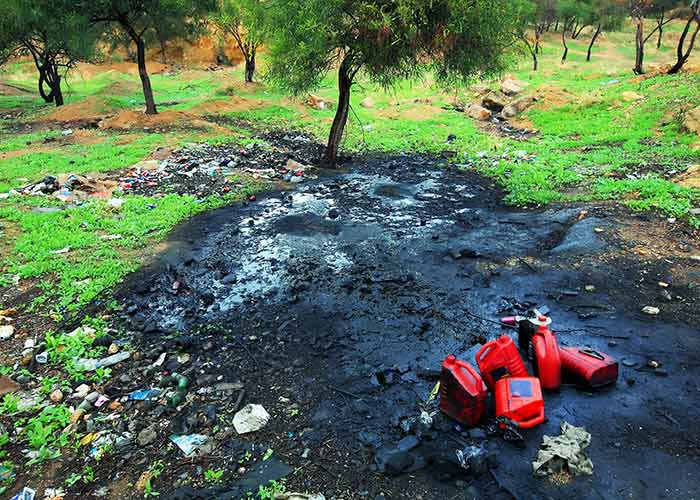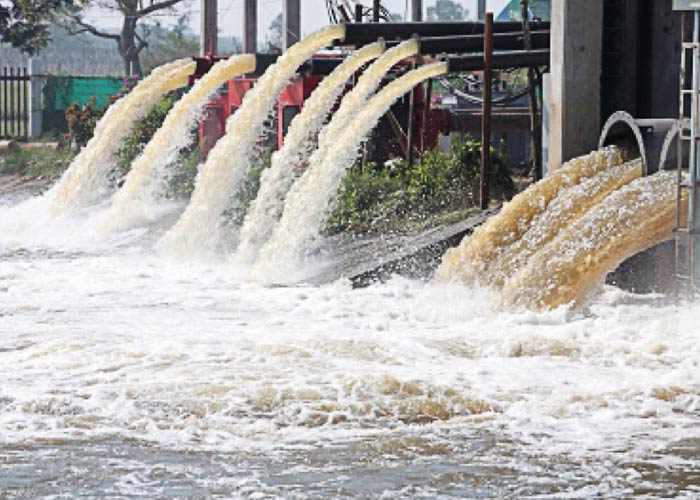What is Soil Pollution?
Any undesirable change in the physical, chemical or biological properties of the soil, which is harmful to environment, living organisms and plants, is called ‘soil pollution’. It adversely affects human nutrition and crop production and productivity, and the quality and utility of soil. Cadmium, chromium, copper, pesticide, chemical fertilizer, weed, toxic gases etc. are major soil pollutants. For example, if pesticides are used while farming, then it affects the plants and the soil apart from killing the insects.
The Problem of Soil Pollution
The problem of soil pollution arises due to mixing of toxic and polluted materials in the soil. Illegal dumping is the biggest reason for soil pollution, which adversely affects the quality of soil and the health of people living on it. Soil pollution also spreads through polluted water absorbed by the soil. Chemical compost used in agricultural work, litter and dirt also badly pollute the soil. The soil is also polluted by the mineral oil spread on the land accidently. Pollutants present in the air also contribute to polluting the soil. Through the rain water, pollutants present in the air descend on the ground which ultimately results into polluting the soil.
Soil is an important natural resource on Earth that is essential to run the life of humankind and animals by producing vegetation, grains and other natural substances required for food and living. Fertile soil on Earth is essential for the production of crops which is essential for the food of all living beings. Fertility of the land is severely affected due to the inclusion of toxic elements in the soil due to chemical fertilizers, pesticides, and industrial effluents.
Let us take into the accounts some statistics. Between the years 1999 to 2000, the farmers worldwide used 18.07 million tonnes of chemical fertilizers and the use of chemical fertilizers is still going on uninterruptedly. These toxic chemicals pollute the soil and ultimately enter the food chain and infect us with dangerous diseases. Even the newborn babies and infants take birth with many types of physical inefficiency due to this phenomenon.
About 1000 square miles of land in Tacoma, Washington had been polluted in minutes due to airborne pollutants falling on the ground; hence the incident is cited as a grave instance of soil pollution.
Harmful chemicals present in the air pour down as acids in the form of rain and contribute to raising the soil pollution to dangerous levels. The direct effect of polluted soil is on the health of men and animals. The crop produced in the soil polluted by harmful chemical substances causes cancer and other incurable diseases by reaching the body of humans and other living organisms.
Due to the large-scale industrialization, industrial effluents are continuously discharged in wastewater. As a result, heavy metals are mixed in soil, turning it toxic.
World scientists have warned from time to time that if there is no attention given on time to soil pollution, it can lead to disastrous consequences. Due to polluted soil, there is an adverse effect on the yield of crops too. Along with the other countries, thousands of hectares of agricultural land in many parts of India have lost their fertility through the constant use of chemical fertilizers.
Types of Soil Pollution
There are many types of natural and human-born soil pollution:
Land pollution from domestic and industrial solid waste
Electronic goods, broken furniture, junk papers, polythene bags, plastic cans, bottles, wastewater, toxic waste from the hospital etc. are examples of solid waste which pollute the soil. Most of this litter is non biodegradable. These wastes affect the soil structure by being blocked in it for long periods. Because these solid wastes do not decay easily, they lie on landfill sites for thousands of years and keep polluting the soil and the environment continuously. In addition to the soil, humans and animals living around these landfill sites are greatly harmed.
Household waste, industrial waste etc. contain residues of harmful toxic inorganic and organic chemicals. In these residues, radiation elements such as strontium, cadmium, uranium, ladders are found, which affect the vitality and fertility of the land. Fly ash is a major source of pollution surrounding the industrial area.
There are chemicals or other types of waste in industries, which are dumped at some place. So much so that soil becomes polluted and trees and plants do not even grow in such a part.
Soil pollution by chemical substances
The use of chemical pesticides and fertilizers has increased for cultivating more crops and these pollutants are making the soil poisonous and in many places the soil has become dead due to excessive use of it.
Producers of fertilizers, insecticides, pesticides, pharmaceuticals produce a lot of solid and liquid waste. Due to leaks from pipes and gutters, pollutants also go into the soil and spread pollution.
In the chemical and nuclear power plants, a large amount of waste is released continuously and due to the absence of proper arrangements for their storage and disposal, these substances pollute the soil.
In commercial agriculture, insecticides are being used indiscriminately and inorganic chemical fertilizers are also being used day by day. The chemical fertilizers are polluting the environment and groundwater resources of phosphate, nitrogen and other organic chemical land. The most dangerous pollutants are bioactive chemicals, due to which the micro-organisms of climates and other soil are being destroyed resulting in decreased quality of soil. Toxic chemicals enter the diet chain, so that they reach the top consumer. Bioactive chemicals are also called Creeping Deaths. In the last 30 years, the use of organic chemicals has increased by more than 11 times. India alone is using 100,000 tonnes of bio-chemicals per annum.
Continuous deforestation
Trees absorb carbon dioxide from the air; provide oxygen for humans and other organisms. Apart from these, tree plantations are also helpful in prevention of soil pollution and erosion. Tree plantation rejuvenates the lost potency of soil. But unfortunately, we are continuously cutting trees on the millions of acres of land for the wood required for construction and the land required for the cultivation, besides mining work.
Factors responsible for soil pollution at a glance
There are many factors responsible for soil pollution such as chemical substances and insecticides, oil spills, landfill dumps and industrial waste etc. Pesticides used in agricultural work are mixed in the air and acid is found in the form of rain. Due to the rapid erosion of forests, the soil has been badly affected by pollution in the world.
Here are prime factors responsible for soil pollution at a glance:
- Continuous drilling in mineral oil and oil wells.
- Mining activities to achieve the essential minerals need to run heavy industries. Wreckage from mining is put in a nearby place. Debris from the excavation of minerals such as stone, iron, ore, mica, copper, etc., eliminates the fertile power of the soil. Together with the water at the time of the rain, the debris goes far away and pollutes the soil.
- Accidents arising during mining activities such as accidents due to accident from oil wells, expansion of oil on land, or during the mining activity for obtaining uranium etc.
- Leakage from pipes being used to transmit oil to the refining plants by the tanks being made for underground oil storage.
- Acid rain carries dangerous levels of pollutants in the air.
- Use of chemical fertilizers to get more crops during agricultural work.
- Industrial accidents due to which hazardous chemicals are mixed in the soil.
- Roads and places where debris is deployed.
- Dehydration of contaminated water in soil.
- Soil disposal of waste, oil and fuels.
- Disposal of atomic waste.
- Construction of landfill and illegal dumping spots.
- Ashes born after burning coal.
- Large amount of electronic waste production.
More on Causes of Soil Pollution…
Effects of Soil Pollution
Pollutants mix in soil and make it toxic and the chemical changes in the natural form of the soil begin to take place. By polluting the soil, in a way, we are destroying the foundation of the food chain. Polluted soil is also contaminating drinking water in the rivers and other sources of water through rain water. Due to chemical fertilizers and bio-chemical chemicals, an imbalance in the entire ecosystem is created.
Soil Pollution: Global Scenario
Russia, China and India are among the countries in the world where pollution of toxic land is spreading rapidly. Chernobyl in Ukraine is remembered for the world’s largest nuclear power accident. After nuclear power accidents, pollutants enter the land also; millions of acres of agricultural land are damaged. The land of Kabai in southern African country Zambia was severely damaged by heavy metals pollution in the year 1987. In La Oroia in Peru, the soil has been polluted due to excessive mining of lead, copper and zinc.
China’s Linfen City’s land has been polluted due to excessive coal mining and pollution of toxic chemicals like arsenic in the soil. Due to soil pollution because of the world’s largest chromite mines in Sukinda of Odisha in India, the lives of the people in this city has become jeopardized. Pesticides are poisonous to human health.Due to excessive production of chemicals such as petrochemicals, pesticides, pharmaceuticals; the soil has become poisonous in Vapi city of Gujarat.
In a study conducted in Uttarakhand in January 2011, it has come to the light that the consumption of urea has increased by two and a half times in a year. Earlier where average four bags of urea were used in the fields, now 10 bags are being used. The use of potash and phosphorus is decreasing and the use of urea is increasing. According to agricultural scientists, this is happening due to the damage done to the top soil of the soil. Deforestation of the upper surface of the soil in mountainous districts is increasing rapidly. This is also leading to the loss of rain. With the increased use of urea, soil health is messing up. The use of unbalanced manure causes the soil to become diseased.
Due to the human activities, a serious problem has been found in the form of soil erosion and soil pollution. The Ministry of Forests of the Government of India estimates that about 57% of the total land of India has been damaged in some way or the other. According to an estimate, about 47 percent of the total area of India is cultivated on agriculture, of which approximately 56-57 percent of the fertile strength has decreased. Similarly, the shadow area of trees is less than 40 percent of the 55 percent of the total forest areas. The figures clearly show the magnitude of the situation.
More on Effects of Soil Pollution …
Know about Diseases caused by Soil pollution…
Measures to Prevent Soil Pollution
There is a need to make stringent rules for reducing soil pollution and preventing it completely. Considering the far-reaching effects of soil pollution, control over it is absolutely necessary. The existence of animal kingdom and plant world is based on soil. The soil is the wealth of the farmers; its deprivation of properties is not only a loss to farmers but to the country’s economy, human health, organisms, and vegetation too.
Throughout the world, the United States and other countries have succeeded in controlling soil pollution through the development of strong regulators, although no major progress in this direction has been made in many large Asian countries such as India and China.
Significantly, in the US, the Comprehensive Environmental Response, Compensation, and Liability Act (CERCLA) has succeeded in establishing several rules for the use of soil, due to which thousands of infected sites have been cleaned up out there. In England, many rules have been made to prevent soil pollution by which the people of the places facing the problem of soil pollution are educated in this regard. Certainly, there is a need to adopt strict rules to control soil pollution, some of which are as follows:
- Domestic waste control
Soil pollution is increasing due to accumulation of domestic waste. There is a need to work according to a well-planned strategy. Most food in household waste is organic waste; to control it, we must store our food more efficiently in the fridge. In this way, we can reduce the waste of food as well as reduce the production of organic waste and prevent these harmful substances from getting into the soil.
- Proper disposal of industrial waste
Chemical pollutants are found in large quantities in industrial wastes, which have a large role in polluting the soil. There is a need to make strict rules for proper disposal of industrial waste and ensure strict adherence to them. The garbage from the factories should be sent to the purifying plants first and they should be immersed only after proper treatment.
- Recycling and Reuse
To reduce the production of soil pollutants, it is necessary that we focus on the recycling and reuse of the items. For example, if you want to throw furniture from your house in the trash, then you should also look for prospects through which you can modify and reuse that furniture.
Like the furniture, we can recycle many waste products in the house, and we can reduce the production of garbage and prevent soil pollution. By throwing domestic waste into landfill sites, we unintentionally increase the amount of carbon in the soil, which is a major factor in soil pollution. Recycling and re-use for the protection of soil is very important.
Other measures
- Limit the use of chemicals in life and adopt Integrated Pest Management.
- In the place of chemical fertilizers, the fundamental properties of soil should be strengthened by adopting Integrated Plant Nutrient Management.
- Use of chemicals like gypsum and pyrites as suggested by scientists for the improvement of salinity-rich soil.
- In order to overcome the water logging in farms, arrangements for drainage are very essential.
- Soil erosion should be prevented by banning forest erosion and adopting soil conservation systems to protect its nutrients.
- Landuse regulations including zoning can reduce the problem of land erosion.
- The construction and implementation of the schemes required to protect the land which is destroyed by floods is essential.
- It is absolutely essential to focus on land utilization and crop management.
More on Prevention and Solutions of Soil Pollution…
Conclusion
Soil, like climate, is also a natural resource, which provides food and living to the creatures/animals. The contribution of land is to organize the water cycle, nitrogen cycle, energy cycle etc. As far as the question of human activities is concerned, land is the basis of all economic activities till the time of harvesting.
As is well known, food is produced from the earth, which is the basic need of human beings. Therefore its purity and purity are very essential. Man is polluting this natural resource from his activities, which is affecting the soil fertility. The use of chemical fertilizers is being done on a large scale to produce more grains for the increasing population. It is necessary to curb this tendency, otherwise we will completely lose the fertility of the soil and the next generation and the life of various creatures will be in jeopardy. The far-reaching consequences of soil pollution can be so dangerous that the very future of human civilization is at stake.
More on Soil Pollution
Causes and Sources of Soil Pollution







